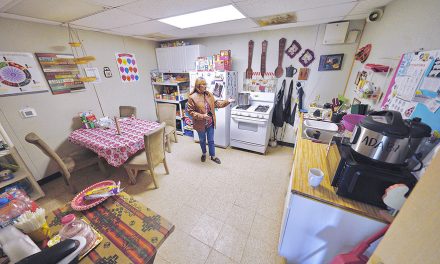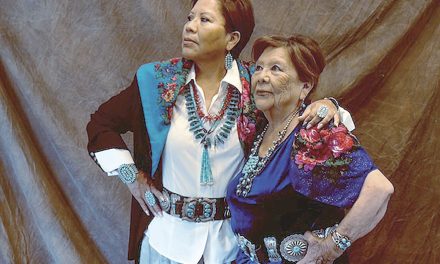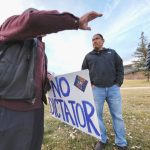
Letters | The new energy economy
The new energy economy
Editor,
As I attended the many graduations with my friends and relatives, I heard many of the grandparents and parents encouraging their children and grandchildren to continue off the reservation at colleges and universities. After that good education many of those young people will not return to the reservation where there is high unemployment and little job opportunities. That is a fact and reality because over 250,000 of our people live off the reservation.
This is why I believe the Resources and Development Committee (RDC) and the president’s office are correct in trying to get energy companies on the reservation. Our leaders are trying to create economic opportunities on the nation with good-paying jobs as they talk with these companies. I have attended some of the meetings that companies like Tallgrass, Greenview, and their tribal partner, NTEC, have hosted. I have not seen any unethical practice towards the grazing permitholders or anyone. In fact, I have seen many of our Navajo people embrace the proposed opportunity.
Yes, the nation has to make a decision to approve the Right of Way (ROW) for the hydrogen line, which NTEC will be the equity owner on behalf of Navajo Nation. As an equity owner the nation will start to receive a minimum of $23 million dollars a year. That is a great start to bring down the $44 million-dollar tribal deficit. On top of that Greenview and Tallgrass have proposed to assist all 13 impacted chapters with a community benefit fund to help their communities just like NTEC does. I have not heard any chapters oppose the plan being proposed by NTEC and their partners.
If groups that are opposed to the project would present an economic plan to match then I think the RDC and president’s office would be open to meeting and listening to them. The Four Corners Clean Energy Alliance (4CCEA) has worked hard to inform the communities about the clean energy project. The 4CCEA staff is all Navajo and their board is majority Navajo, which includes NTEC. The 4CCEA Navajo staff have been very professional and all of them are passionate about helping their people. Two of 4CCEA staff are former Navajo Council members.
Our leaders know there is a great opportunity with CO2 capture and hydrogen in this new energy economy. We, the people, and our elected leaders must create opportunities for the future children of the nation. The new energy economy is at Navajos doorstep and RDC, Council, and the president’s office must move forward to be part of that new energy economy. Our goal should be to bring our bright young people back to the reservation with good-paying jobs and opportunities in this new energy economy, which includes hydrogen. This is one way we Navajos will maintain our culture, language, and tradition.
Thanks for giving me the opportunity to set the record straight on what is happening out in the communities.
Denise Begay
Hogback, N.M.
Questions about uranium and its local history
Editor,
Dear Mr. Chalmers,
Thank you for your letter to the Navajo Times explaining the benefits of uranium extraction, milling, and transport on the Colorado Plateau and across Diné Bikéyah. I appreciate your position as the CEO of an energy corporation and your company’s interest in a partnership with the Navajo Nation, but I wanted to take this opportunity to personally respond to a few of the points that you raise, ask a few questions, and take the opportunity to illuminate the conversation for people that like to talk things out.
The use of łeetsoii on the Navajo Nation begins with its stories, and its traditional application as a substance in ceremonial occasions far predating any western mining operation on the Navajo Nation. Yet if we consider the facts further, uranium milling has been happening near Diné Bikéyah since the 1890s when Marie Curie first visited the region. You neglected to mention the Church Rock uranium mill pond spill of July 1979 in your letter, but this catastrophic event extends the chronology of uranium mining by at least two more decades. Yet as an historian that specializes in this topic, my point is that uranium extraction has been ongoing here for roughly eight decades rather than two, and while you explain the “nature” of uranium in your letter, you’ve neglected to recognize its use as a ceremonial substance while instead privileging its scientific and economic meanings. It is a mistake to understand the history and the value of uranium on the Navajo Nation in only these ways, just as it is to silence the long-kept stories of łeetsoii that too often escape western ears.
Second, you’ve made the lofty claim that Energy Fuels is willing to sweep onto the scene to begin cleaning up the abandoned uranium mines on the Navajo Nation. However, you do not acknowledge any of the cleanup work done by Diné communities at NEPA, NAMLRD, and UMTRA over the past decades. Why should Energy Fuels be permitted to conduct cleanup operations when your letter essentially erases the work of these Diné first responders? Since the 1980s, in fact, the reclamation of around 900 abandoned uranium mines and about three-hundred coal mines has occurred on Navajo trust lands at a cost of nearly $40 million dollars. There have also been remediation efforts underway at the five existing abandoned mill sites on the Navajo Nation since the 1970s, and efforts to build and improve infrastructures. How would your company build upon this work and legacy?
Lastly, if Energy Fuels were permitted to conduct cleanup operations, would it be willing to warranty and maintain abandoned uranium mine sites for the hundreds and thousands of years that will be required to ensure a generationally suitable solution is achieved? Thank you.
Don Unger, Ph.D. candidate
University of Arizona, Department of History
Tucson, Ariz.
Criteria for running for leadership posts
Editor,
Election time is an opportunity to build a strong and engaged community.
The Navajo Nation election website shows the list of the 2024 Táá’ Naaznilí or Naat’áanii candidates (local chapter officials and school board). I recognize many names of re-recycled or career politicians (CP). These CP’s may have more experience and a long track record for being on the board or a chapter official, they may have established networks, and they may be seen as older, more stable, and reliable, which makes them more appealing to provide long-term stability and continuity.
I also wonder why the CPs choose to stay on. Fear of change, comfort in staying in a familiar role, even if it is not the best fit for them. Reluctant to give up power and control, use public position for personal gain or family and friends, or feel entitled. Lack of alternatives, no skills, or experience to do anything else. Serving on multiple boards provides extra income, just go through the motions and show up at meetings and get paid. When you serve on multiple boards, how can you be efficient and effective?
Serving on a board requires a significant time of commitment, including attending meetings, reviewing materials, and engaging in strategic planning and decision-making. Term limits could be a way to break the incumbency advantage, the insulated class of career politicians, and give new candidates a chance to claim nominations.
Many public or chapter members are disenfranchised from the chapter as many of them have lost hope. I have been going to chapter meetings since I was a small kid. I learned about the Naat’áanii or Táá Naaznilí as a group of guides or leaders nominated and voted in by members of the local community. I saw that the chapter was a place where the Naat’áanii or Táá Naaznilí and many community people gathered to share information, discuss ways to improve the community, and celebrate.
During the chapter meetings, these leaders listened and involved the community members present to address the people’s concerns. The leaders were productive and got the job done. When the community began losing public confidence in them, leaders either stepped down or the community voted for new leaders. Now, there are too many leaders (President, Vice President, Secretary…) and little to no progress, and leaders and/or officials are stealing money and getting away with it. People raise concerns to the leaders, but nothing happens, people go to the next meeting and raise questions and concerns, and nothing happens. It leaves one to wonder who is responsible for initiating and following through to ensure proper measures are taken to address the corruption.
To move forward, we need new innovative leaders. New or younger people may not have as many opportunities to gain leadership experience, which can make it harder for them to compete for leadership roles.
Must Have Skills for Naat’áanii or Táá Naaznilí:
· Confidently articulate their understanding of their required and specific roles and responsibilities.
· Attend meetings consistently, No AWOL.
· Know how to run meetings using well-enforced rules to take the confusion and chaos of who speaks, what comes next, staying with the agenda.
· Demonstrate good reading, writing, and math skills, to enable them to read and understand policies, analyze budgets, and communicate effectively with others to enact many of the goals.
· Use authority to ensure all chapter officials follow open meeting laws including giving a 24-hour notice, an agenda to inform the public of the matters to be discussed or decided and informing the public by posting meeting minutes.
· Hire a qualified-skilled chapter manager who will manage activities using the policies and procedures manual (financial, hiring, administering assistance).
· Use authority to supervise and/or correct chapter manager and office staff who lack people skills.
· Encourage, model, or elicit the other Naat’áanii or Táá Naaznilí to make meaningful contributions during the meeting and not just passengers on the ship, but who are willing to take the helm and steer us in a new direction.
· Address the underrepresentation of young people in leadership positions such as encouraging mentorship, providing opportunities to gain leadership experience, acknowledging the value that young people can bring to leadership roles, and fostering and bridging intergenerational collaboration and knowledge.
Marilyn Decker
Nazlini, Ariz.








 Highway 264,
Highway 264, I-40, WB @ Winslow
I-40, WB @ Winslow